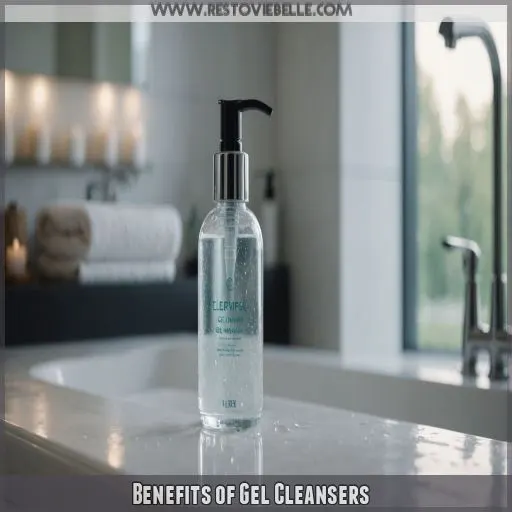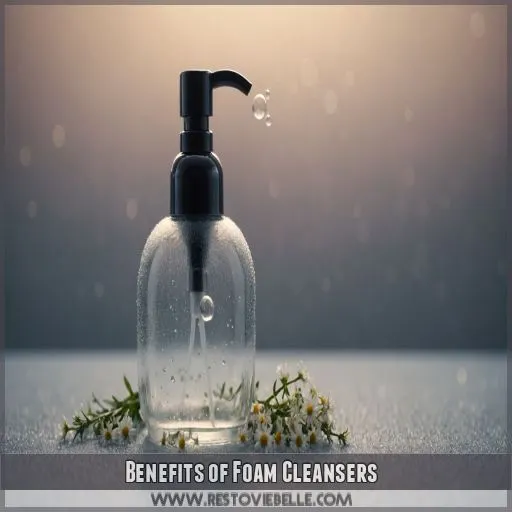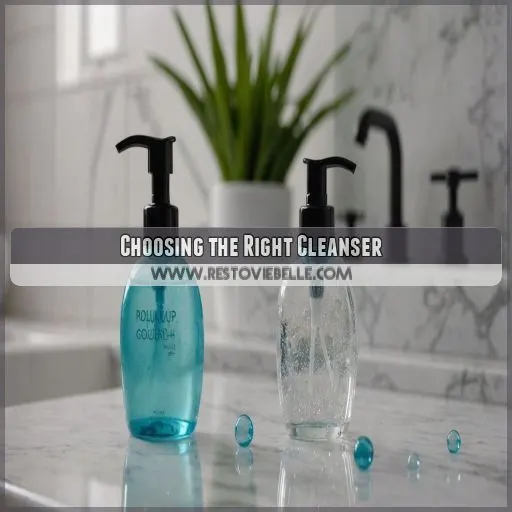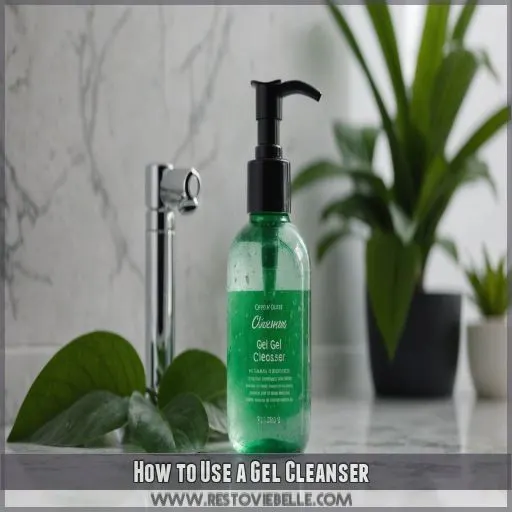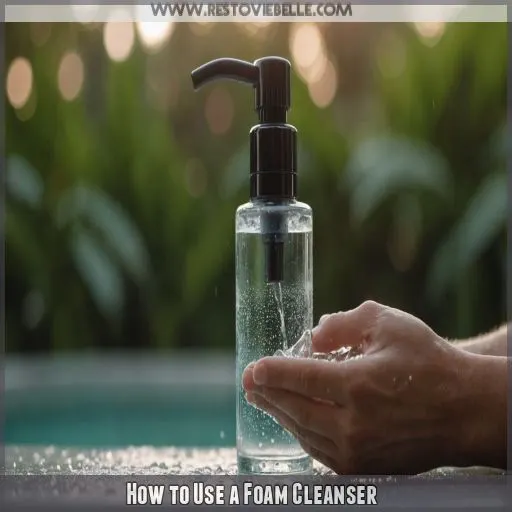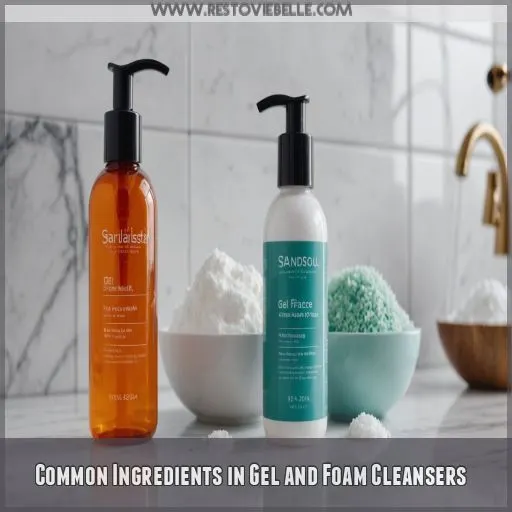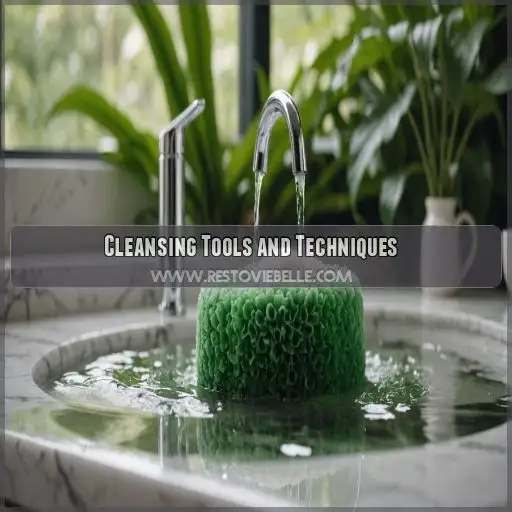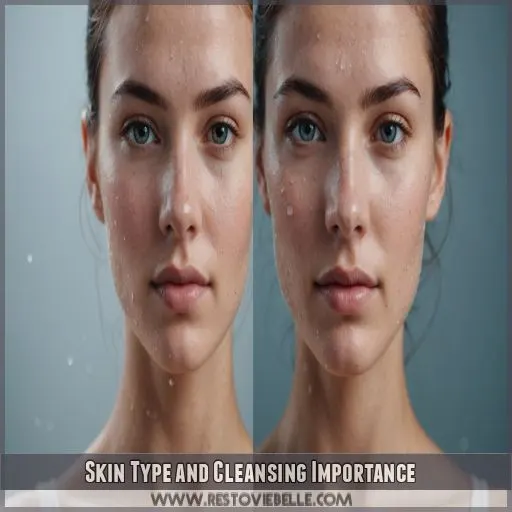This site is supported by our readers. We may earn a commission, at no cost to you, if you purchase through links.
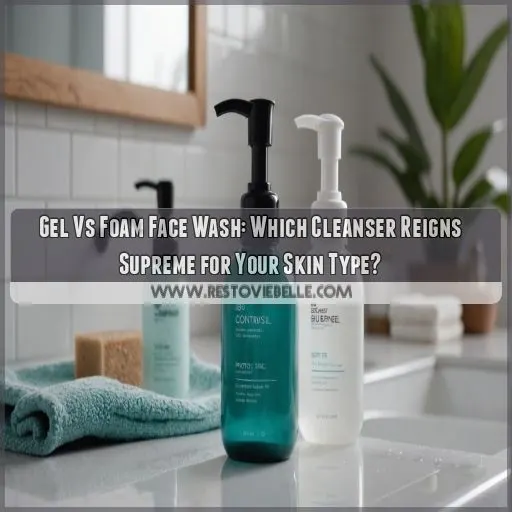
It’s time to get down to business.
Gel cleansers are like the gentle giants of the skincare world – perfect for sensitive and dry skin.
They’re all about maintaining moisture and soothing inflammation.
Foam cleansers, on the other hand, are like the oil-busting superheroes – great for oily skin and removing surface oils and makeup.
But, be warned: they can be more alkaline than gel cleansers.
So, which one is right for you?
Let’s figure out what your skin is really craving.
Table Of Contents
- Key Takeaways
- Gel Vs Foam Face Wash
- Benefits of Gel Cleansers
- Benefits of Foam Cleansers
- Choosing the Right Cleanser
- How to Use a Gel Cleanser
- How to Use a Foam Cleanser
- Common Ingredients in Gel and Foam Cleansers
- Cleansing Tools and Techniques
- Skin Type and Cleansing Importance
- Frequently Asked Questions (FAQs)
- Which is better, gel or foam cleanser?
- Which is better, foaming or liquid face wash?
- Which face wash is better gel or cream?
- Why not to use foaming face wash?
- Can I use both gel and foam face wash together?
- Are gel cleansers suitable for acne-prone skin types too?
- How often should I use a foam face wash daily?
- Do gel face washes remove makeup effectively like foam cleansers?
- Can I use a gel face wash on oily skin ever?
- Conclusion
Key Takeaways
- You’re the real champion here, and your skin type is the deciding factor in the gel vs. foam face wash showdown. Gel is perfect for sensitive and dry skin, while foam is better suited for oily and combination skin.
- Don’t be afraid to get a little personal and consider your skin concerns when choosing a cleanser. If you’re dealing with dryness, look for a gentle gel that soothes and calms. If you’re oily, opt for a foam that controls oil production.
- You can have your cake and eat it, too – or in this case, use both gel and foam face wash together. However, be cautious not to over-cleanse. Pair a gentle gel for daily cleansing with a foaming wash for deeper cleaning 1-2 times a week.
- Remember, the right cleanser is just the beginning. Combine it with a solid routine, patience, and a dash of self-love, and you’ll be on your way to radiant, healthy-looking skin that’s the real champion.
Gel Vs Foam Face Wash
You’re standing in front of the skincare aisle, staring down at rows of gel and foam face washes, wondering which one is right for you. It’s time to get down to business and figure out whether a gel or foam cleanser is the best fit for your skin type and needs.
Key Differences in Texture and Formula
The key differences between gel and foam face wash lie in texture and formula.
Gel cleansers have a thick, gel-like consistency and emollient qualities. They are distinct from foam cleansers, which are lightweight and airy, producing a foamy lather.
Surfactant types and pH balance also vary between gel and foam cleansers, impacting their cleansing efficacy.
Understanding these differences will help you choose the perfect cleanser for your skin.
Skin Type Suitability for Gel and Foam
Choosing between gel and foam face wash ultimately depends on your skin type. Gel cleansers are perfect for sensitive and dry skin, while foam cleansers are better suited for oily and combination skin. But, what about normal skin? Don’t worry, rest assured, you’re in good hands!
- Combination skin: Opt for a gentle gel or foam that balances oil and moisture.
- Sensitive skin: Select a fragrance-free gel that soothes and calms.
- Normal skin: Try a lightweight foam that cleans without stripping natural oils.
- Oily skin: Choose a foam that deeply cleans pores and controls oil production.
In selecting the ideal face wash, your skin type is the deciding factor.
Ingredient Comparison for Gel and Foam
In the case of gel and foam cleansers, the ingredients are what set them apart. Let’s break it down:
| Gel Cleanser | Foam Cleanser |
|---|---|
| Amino acid rich sudsing agents | Sodium lauryl sulfate (SLS) |
| Natural oils and emulsifiers | Higher pH level |
| Moisturizing properties | Can be drying |
Now that you know the difference, which one is right for your skin type?
Benefits of Gel Cleansers
You’re likely no stranger to the great gel vs foam face wash debate, but if you have sensitive or dry skin, gel cleansers are definitely worth considering. With their gentle, non-stripping formulas, gel cleansers can help maintain moisture and soothe inflammation, making them a top pick for those who need a little extra TLC.
Gentle and Non-Stripping Formula
Gel cleansers are a game-changer for those seeking a gentle, non-stripping formula. Their soothing properties calm irritated skin, while natural oils provide long-lasting hydration. Look for pH-balanced, non-comedogenic formulas that won’t clog pores. With a gentle gel cleanser, you can say goodbye to dryness and hello to supple, healthy-looking skin that radiates a natural glow.
Suitable for Sensitive and Dry Skin
If you’re dealing with sensitive or dry skin, a gentle gel cleanser is your BFF! It’s formulated to clean without stripping your skin of its natural oils. Here are three reasons why gel cleansers are perfect for fragile skin:
- They’re often fragrance-free, reducing the risk of irritation.
- They contain soothing ingredients like aloe vera or green tea.
- They’ve emollient bases that help lock in moisture.
Maintains Moisture and Soothes Inflammation
You’ll love how gel cleansers maintain moisture and soothe inflammation, especially if you have sensitive skin. Hydrating ingredients like centella asiatica and aloe vera work wonders. These anti-inflammatory superheroes calm redness and irritation, leaving your skin feeling fresh and hydrated. Unlike harsh foams, gel cleansers are gentle and non-stripping, making them perfect for sensitive skin types.
Benefits of Foam Cleansers
Foam cleansers are great for removing surface oils and makeup, leaving your skin feeling clean and refreshed – especially if you have oily skin. But remember, foam cleansers can be more alkaline than gel cleansers (Source), which might mess with your skin’s pH balance. So, you want to pick a formula that works with your skin type (Source).
Effective for Removing Surface Oils and Makeup
Foam cleansers are your BFF for removing surface oils and makeup. They’re like a magic eraser for your skin! Unlike micellar water, foam cleansers can provide a deeper clean without stripping your skin of its natural oils. Plus, they’re often gentler than makeup remover alternatives. Give them a try in your double cleansing routine!
Provides a Refreshing Feel and Suitable for Oily Skin
The clean feeling of a foam cleanser – it’s like a fresh start for your skin!
If you have oily skin, you’ll love how foam cleansers leave your face feeling clean and revitalized.
They’re perfect for acne-prone skin, as they help control oil production and reduce breakouts.
A good cleanse is just what you need to start your day off right!
Can Be More Alkaline Than Gel Cleansers
Regarding foam cleansers, be aware that they can be more alkaline than gel cleansers. This mightn’t be ideal for your skin, as an alkaline pH can disrupt your skin’s natural balance. Choose a cleanser with a pH level close to your skin’s natural pH (around 5.5) to avoid irritation and facilitate effective cleaning.
Choosing the Right Cleanser
You’re on a mission to find the perfect cleanser, but with so many options out there, it can be overwhelming. To make things simpler, let’s break it down: choosing the right cleanser is all about understanding your skin type and what it needs, and then finding a gel or foam that fits the bill.
Consider Skin Type and Personal Preference
Choosing the right cleanser is all about finding your perfect match. Consider your skin type: gel for dry or sensitive skin, foam for oily or combination skin. But don’t forget about personal preference! Do you like a hydrating cleanse or an invigorating feel? Customized cleansing is key. Let your skin concerns guide you to the perfect cleanser.
Patch-Testing New Products for Compatibility
Now that you’ve considered your skin type and personal preferences, it’s time to patch-test new products for compatibility. Don’t skip this step, especially if you have skin sensitivity concerns! Analyze the product’s ingredients, apply a small amount to a discreet area, and wait 24-48 hours for any signs of an allergic reaction. Your skin will thank you!
Consulting a Skincare Expert for Personalized Recommendations
Want to find your perfect cleanser match? Consider consulting a skincare expert! They’ll analyze your skin type, concerns, and goals to provide personalized product advice. Here are just a few benefits:
- Get a custom routine built just for your unique skin needs
- Receive expert ingredient guidance to avoid harsh chemicals
- Enjoy a deep cleaning and radiant glow without breaking the bank
How to Use a Gel Cleanser
Using a gel cleanser right is key. You want to find the sweet spot, not too much, not too little, just the perfect amount to effectively cleanse your skin without stripping it of its natural oils.
To get the most out of your gel cleanser, follow these simple tips to learn how to apply, massage, and rinse your way to radiant, healthy-looking skin.
Applying the Right Amount and Massaging Technique
When using a gel cleanser, apply a pea-sized amount and gently massage it onto your face in a circular motion with your fingertips. Be gentle, don’t scrub! Use light pressure and smooth strokes to work the cleanser into a milky lather. Focus on one area at a time, and avoid the delicate skin around your eyes.
Rinsing and Patting Dry for Optimal Results
Now that you’ve massaged that gel cleanser onto your skin, it’s time to rinse and pat dry.
Use lukewarm water to rinse, then gently pat dry with a soft towel.
Don’t rub, as this can irritate your skin.
For an extra dose of moisture, try adding a few drops of safflower seed oil or sunflower seed oil to your skin while it’s still damp.
Tips for Sensitive Skin and Combination Skin
Now that you’ve mastered the art of rinsing and patting dry, let’s talk sensitive skin and combination skin tips. For sensitive skin, opt for gentle, fragrance-free gel cleansers and avoid exfoliating too frequently. Combination skin? Balance your cleansing routine with a gel cleanser on oily areas and a cream cleanser on dry spots. Easy peasy!
How to Use a Foam Cleanser
You’re ready to give foam cleansers a try, but you’re not sure where to start.
Don’t worry, using a foam cleanser is a breeze, and with a few simple tips, you can get the most out of your cleansing routine.
To use a foam cleanser effectively, you’ll want to create a rich lather and massage it onto your skin with a gentle, circular motion.
Then, rinse thoroughly to reveal clean, refreshed skin.
Creating a Rich Lather and Massaging Technique
To create a rich lather, use lukewarm water and a small amount of foam cleanser. Massage the lather onto your skin with gentle, circular motions. Be mindful of the foam density – too much can strip your skin of its natural oils. Use a gentle touch and rinse with warm water for a clean feeling.
Tips for Oily Skin and Combination Skin
When using a foam cleanser on oily or combination skin, be gentle! Massage the lather onto your face for about 30 seconds, then rinse with warm water. For oily skin, use a lightweight, oil-free moisturizer to balance your skin’s natural oils. For combination skin, focus on hydrating products on dry areas and oil-control products on oily areas.
Common Ingredients in Gel and Foam Cleansers
If you’re looking at gel and foam cleansers, you’ll see a bunch of ingredients that can either be good or bad for your skin.
Let’s break down the common ingredients found in these cleansers to help you make an informed decision about what works best for your skin type.
These ingredients include:
- Sodium lauryl sulfate (SLS)
- Amino acid rich sudsing agents
- Natural oils and emulsifiers
Sodium Lauryl Sulfate (SLS) and Its Effects
You’ve probably heard of Sodium Lauryl Sulfate (SLS) when it comes to foam cleansers.
It creates that rich lather we all love, but SLS can also cause irritation, especially if you have sensitive skin.
If you’re noticing redness or itchiness, you might want to consider SLS-free products or alternatives like gentle surfactants.
It’s important to weigh the benefits against the potential drawbacks and prioritize your skin’s comfort and safety.
Amino Acid Rich Sudsing Agents and Their Benefits
If you’re looking for a gentle cleanser, amino acid rich sudsing agents are the unsung heroes. They create a rich lather without stripping your skin of its natural oils, making them perfect for sensitive skin. Here are just a few benefits:
- Help maintain skin pH balance
- Gentle enough for daily use
- Can be used in place of harsh surfactants like SLS
Natural Oils and Emulsifiers for Moisturizing Properties
Now that we’ve covered amino acid rich sudsing agents, let’s talk about natural oils and emulsifiers that bring moisturizing properties to your cleanser. Think coconut oil and shea butter – they’re like a drink of water for your skin. Here’s a snapshot of their benefits:
| Natural Ingredient | Moisturizing Effects |
|---|---|
| Coconut Oil | Hydrates and nourishes dry skin |
| Shea Butter | Locks in moisture and soothes irritation |
| Emulsifiers | Help blend oil and water for a gentle cleanse |
These natural ingredients are a win-win for your skin.
Cleansing Tools and Techniques
If you’re looking to get the most out of your cleansing routine, having the right tools can make a big difference. By using cloths, mitts, sponges, and electric face brushes, you can make cleansing more effective, exfoliate better, and even give your skin a healthy glow.
Using Cloths, Mitts, and Sponges for Exfoliation
Time to get scrubbing! Using cloths, mitts, and sponges can elevate your exfoliation game. Here’s the lowdown:
- Cloths gently buff away dead skin cells
- Mitts provide a deeper exfoliation and massage
- Sponges are perfect for sensitive skin and everyday use
- Use lukewarm water and a gentle touch to avoid irritation
- Exfoliate 1-3 times a week for radiant, healthy-looking skin
Electric Face Brushes for Tightening Pores and Boosting Radiance
You’re upgrading your cleansing game with an electric face brush! These nifty tools can tighten pores and boost radiance. With various brush types to suit your skin sensitivity, you can customize your routine. Gently massage your face with the brush for about 30 seconds, 2-3 times a week. Remember, be gentle – your skin will thank you!
Cleaning and Maintaining Cleansing Tools
Hey there, friend! Don’t forget to give your cleansing tools some TLC. Regular cleaning and maintenance can extend their lifespan and prevent bacteria growth. Depending on the material, you can DIY a cleaning solution or replace them every 1-3 months. Make it a routine to clean your tools weekly and enjoy a healthier, happier skin!
Skin Type and Cleansing Importance
Choosing the right cleanser is all about knowing your skin type. By figuring out whether you have dry, oily, combination, or sensitive skin, you’ll be able to pick a gel or foam face wash that effectively cleanses and nourishes your skin without causing irritation or dryness.
Determining Your Skin Type With the Bare-Faced Method
Ready to get bare-faced and figure out your skin type?
Try the Bare-Faced Method!
Cleanse your skin and wait 30 minutes to examine its natural state.
If it’s shiny, especially on the T-zone, you’re likely oily.
If it’s flaky or tight, you’re dry.
Combination skin? You’ll see a mix of both.
Knowing your skin type is key to finding your perfect cleanser match.
Understanding the Importance of Cleansing for Different Skin Types
Now that you’ve determined your skin type, let’s talk about why cleansing matters. For oily skin, it’s about controlling sebum production. For dry skin, it’s about locking in moisture. And for sensitive skin, it’s about avoiding irritation. A consistent cleansing routine can make all the difference. Take a skin type quiz to tailor your approach and get the best results.
Customizing Your Cleansing Routine for Optimal Results
Now that you know your skin type and the importance of cleansing, it’s time to customize your routine for the best results. Think of your cleansing routine like a recipe – you need the right ingredients, in the right amounts, at the right time. Here are some tips to get you started:
- Adjust your cleansing frequency based on your skin type and lifestyle.
- Consider double cleansing at night to remove makeup and impurities.
- Be gentle in the morning, and save exfoliating for nighttime.
- Use a toner to balance your skin’s pH and tighten pores.
- Experiment with different products and techniques until you find what works for you.
Frequently Asked Questions (FAQs)
Which is better, gel or foam cleanser?
Choosing a cleanser is like finding your perfect match – it’s all about compatibility. If you have dry or sensitive skin, gel is likely your best bet, while foam is better suited for oily or combination skin.
Which is better, foaming or liquid face wash?
Choosing the right face wash can feel like a puzzle, especially when you’re trying to decide between foaming and liquid options.
It really comes down to your skin type and what it needs.
If you’re dealing with oily skin, a foaming face wash might be your best bet.
But if you have dry or sensitive skin, a liquid cleanser is usually the way to go.
Don’t be afraid to experiment and find what works best for you!
Which face wash is better gel or cream?
Choosing between a gel and cream face wash depends on your skin type. If you have dry or sensitive skin, a cream cleanser is your best bet, while gel is ideal for combination or oily skin types.
Why not to use foaming face wash?
Imagine washing your face with a harsh detergent – ouch! That’s what foaming face wash can feel like, especially if you have sensitive skin. You might want to reconsider using it if you notice dryness, irritation, or redness.
Can I use both gel and foam face wash together?
Hey, can you use both gel and foam face wash together? Absolutely, but be cautious not to over-cleanse! Pair a gentle gel for daily cleansing with a foaming wash for deeper cleaning, 1-2 times a week.
Are gel cleansers suitable for acne-prone skin types too?
You’re wondering if gel cleansers are suitable for acne-prone skin? Generally, gel cleansers are gentle and non-comedogenic, making them a great option for acne-prone skin, but look for ones labeled "oil-free" or "non-acnegenic" to be safe.
How often should I use a foam face wash daily?
Using a foam face wash daily can be a bit harsh. Limit it to 1-2 times a day, depending on your skin type. Over-washing can strip your skin of its natural oils, leading to dryness and irritation.
Do gel face washes remove makeup effectively like foam cleansers?
You’re wondering if gel face washes can remove makeup as effectively as foam cleansers? The answer is yes! Gentle gel cleansers can dissolve and lift makeup without stripping your skin of its natural oils.
Can I use a gel face wash on oily skin ever?
Can you really use a gel face wash on oily skin? Actually, yes! If you choose a gentle, oil-free gel cleanser that balances cleansing and moisturizing properties, it can work wonders for your oily skin.
Conclusion
The verdict is in: the gel vs foam face wash showdown has a winner – your skin!
By now, you’ve discovered whether you’re a gentle gel giant or an oil-busting foam fanatic.
Whichever team you’re on, remember that the right cleanser is just the beginning.
Combine it with a solid routine, patience, and a dash of self-love, and you’ll be on your way to radiant, healthy-looking skin that’s the real champion.

